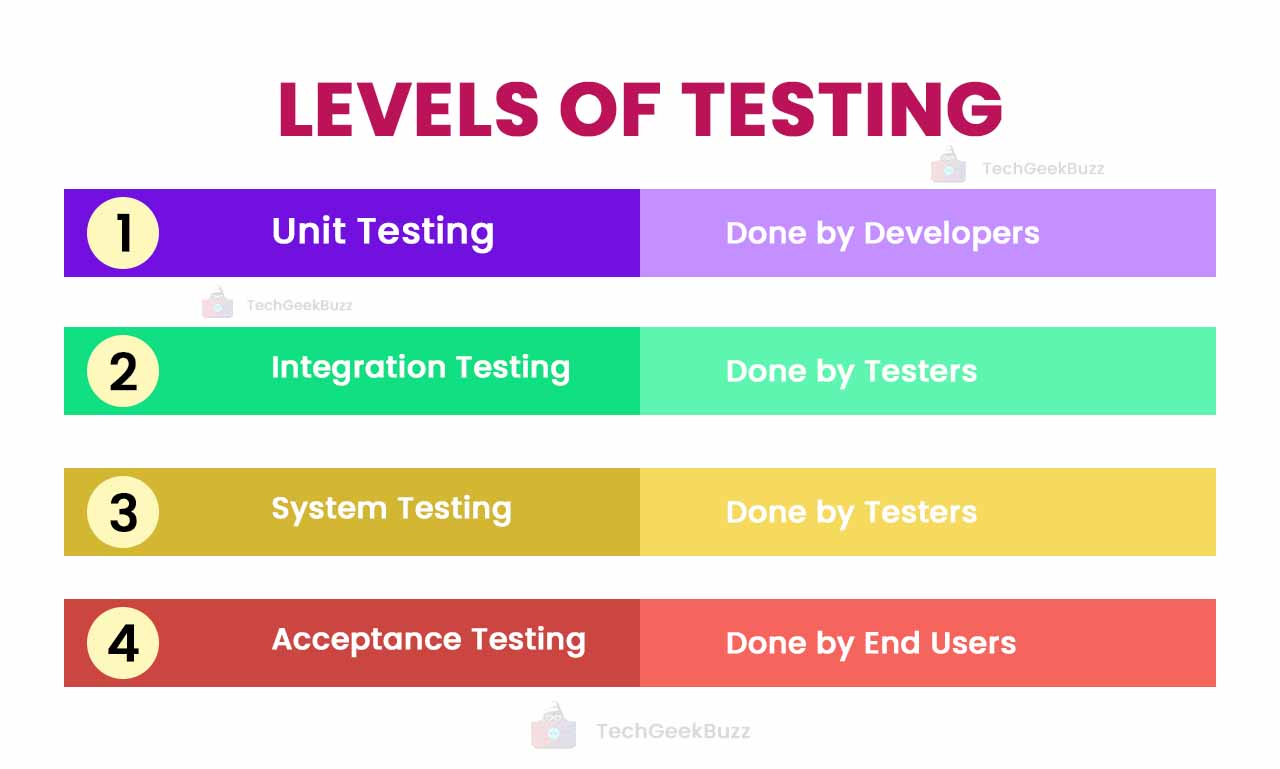Being an inevitable and inescapable aspect of the software development life cycle (SDLC), software testing is a method or act of evaluating a software product to verify that it entirely complies with the quality standards and the end user’s requirements. The testing procedure also makes sure that the software product is error-free and operates as planned.
The ultimate objective of software testing is to deliver top-notch and fully-functional software products. In order to accomplish this goal, it is crucial to carry out the software testing procedure methodically. And different levels of software testing help to assure that the testing process has been carried out methodically.
There are various levels of testing, ranging from testing each individual component (module) of the software product to testing it as a whole to find potential flaws. These different levels of software testing evaluate the software product’s performance and behavior in different phases of SDLC .
There are four levels of testing, as follows:
- Unit testing
- Integration testing
- System testing
- Acceptance testing
Every phase of SDLC, requirement gathering and analysis, designing, coding or implementation, testing, deployment, and maintenance, has to go through these four software testing levels.
In this blog post, we shall make you familiar with all different levels of software testing in detail.
So, let us begin without wasting time!
Levels of Software Testing
Each level of software testing has its own objectives, pros, and cons. Let us now discuss each software testing level in detail below.

1. Unit Testing
It is the first level of testing. A unit refers to a single component or module of the software product that can be compiled, tested, and executed. So, as its name implies, unit testing is the process of evaluating each and every unit of the software product in isolation to confirm that it functions as expected. We refer to unit testing as component testing as well.
The principal goal of unit testing is to confirm that each module of the software product is fulfilling its intended purpose. Generally, software developers are in charge of performing unit testing. It is a white-box testing technique as developers test the code of every software component.
Pros
- Allows developers to verify the correctness of each and every component of the software product.
- Uncovers bugs and errors in components before they pass on to the next level of testing, integration testing.
- Splits the entire source code into manageable chunks, with each code chunk referring to a single component. This code modularity results in the reusability of components.
- Reduces costs significantly by identifying defects and errors early in the development process.
- All units or modules are independent of each other.
Cons
- Time-consuming to create unit test cases for every component.
- Does not guarantee the discovery of all errors.
- Not suitable for testing user interfaces.
- Challenging to create good quality unit tests.
2. Integration Testing
It is the second level of software testing. As its name suggests, integration testing unites various tested components of the software products logically and puts them all together through a test.
The primary objective of this testing level is to ensure the proper data flow between different components of the software product combined logically into a group. To put it simply, integration testing ensures the proper communication between integrated software components. It primarily discloses errors in the interaction between the software components.
Performing integration testing is the responsibility of software testers. They can leverage any of the three software testing methods, white-box, black-box, and grey-box testing . This testing level takes place following the unit testing and prior to system testing.
Pros
- Confirms that there are no barriers preventing the communication between the various software components.
- Discloses issues in the interaction of the software components.
- Ensures that components after integration function properly.
- Bugs detected at this level are easier to fix.
Cons
- Pretty challenging to carry out.
- Resource-intensive and time-consuming.
- Requires the creation of stubs and drivers.
- Results into inadequate testing if the stubs and drives are not created correctly.
3. System Testing
It is the third level of software testing. At this level, the software product undergoes testing in accordance with its functional and non-functional requirements. System testing entails testing the integrated components as a whole.
The foremost objective of system testing is to determine whether the system (integrated components as a whole) complies with the specified requirements. It is end-to-end testing that checks the end-to-end flow of the software product.
Like integration testing, software testers are in charge of performing testing. They conduct this testing level prior to acceptance testing and following integration testing. System testing is the first type of software testing in SDLC that examines the software product as a whole. In addition, it is a black-box testing technique as it does not peer into the code or internal structure of the software product.
Pros
- Testers need not have programming knowledge to perform system testing.
- Evaluates the software product as a whole.
- Discloses errors that were left uncovered during the unit and integration testing.
- The testing environment is analogous to the real-time production environment.
Cons
- Time-consuming as compared to other testing levels.
- The cost required is pretty high as it entails testing the entire software product.
- Requires an excellent debugging tool to leave no hidden defects uncovered.
4. Acceptance Testing
The last level of software testing is acceptance testing. It involves the evaluation of the software product for its correctness by a small group of real users or clients and stakeholders. It is the final testing level carried out before making the software product live to customers.
Acceptance testing's ultimate goal is to check the final product’s acceptability and readiness to make it live. Like system testing, acceptance testing is also black-box testing. When the software product is in the final testing level, it indicates that it has passed all the aforementioned three testing levels.
Furthermore, the two major types of acceptance testing are: alpha testing and beta testing . While the internal members of an organization other than the development team perform alpha testing, the real users perform beta testing on the software product.
Pros
- Increased client and customer satisfaction.
- Users carrying out acceptance testing gain knowledge and experience of the software product.
- Easy to perform if the quality requirements are specified at the start of the development process.
Cons
- Finding users for testing is pretty challenging as they don’t wish to get involved in the testing process.
- Users need assistance from software testers as it becomes difficult to comprehend the test cases developed by testers.
Unit vs Integration vs System vs User-Acceptance Testing
|
Testing Level |
Level Number |
What it Tests |
Objective |
Testing Method |
Who Performs |
|
Unit testing |
1 |
Each component or module of a software product |
To check each component for its correctness |
White-box |
Developers |
|
Integration Testing |
2 |
Interaction between the software components |
Disclose defects in the interaction of software components |
White-box, black-box, and grey-box |
Testers |
|
System Testing |
3 |
Integrated components as a whole |
To make sure the system complies with the requirements |
Black-box |
Testers |
|
Acceptance Testing |
4 |
The entire software product |
To determine whether the software product is ready to launch in the market or not |
Black-box |
Clients/Stakeholders or real users |
Conclusion
This brings us to the end of levels of software testing. In order to ensure that the testing process is performed systematically without any interruptions, it is essential to rigorously adhere to the sequence of software testing levels. Right from the first phase of SDLC to the last, all the phases undergo these testing levels. Such frequent and early testing uncovers errors at the early stages of development, which, in turn, lowers the cost of fixing them at later stages.
We hope you now have a thorough understanding of the levels of software testing after going through this article.
People are also reading:



![What is Waterfall Model? [Phases, Pros, & Cons]](/media/new_post_images/Waterfall_Model.webp)

Leave a Comment on this Post